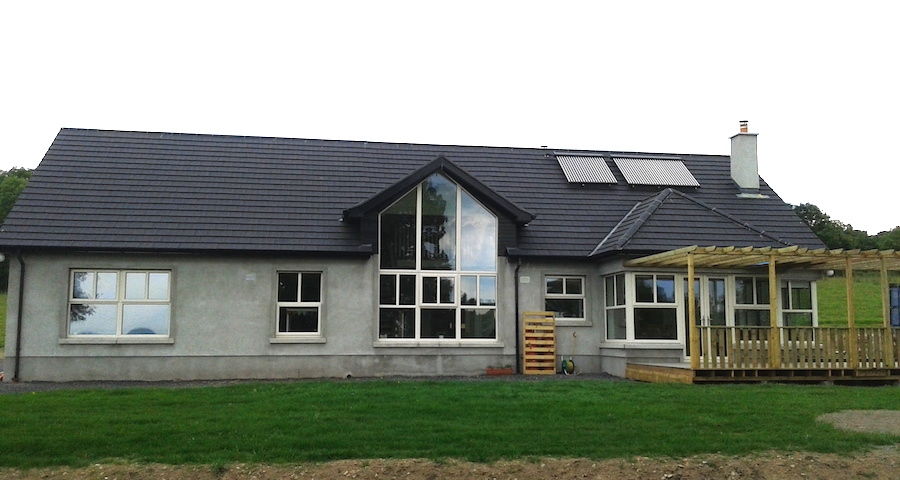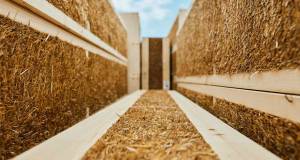
- Blogs
- Posted
The High Garden House: a personal experience of low energy building
In this blog post, Paul Doran recalls the challenges and lessons of building a low energy home on a tight budget for his family.
In 2012 I employed my father Pat Doran to build a family home for my wife and two young children. Up to that point we had a long experience of renting cold and miserable houses with high heating bills. Consequently we were keen to build a house where we could be warm and comfortable without dreading the heating bill every winter.
My growing concern with rising fuel costs had coincided with working on some of Pat’s recent projects. While on site I had observed and grown quite envious of the new high standards of insulation and air tightness that were rapidly becoming the norm. I felt if I were the client I would be able to push low energy construction even further in my own build. I also had an exciting design from DH Architectural which made the most of passive solar gain, but there was a real concern that a house to the high spec I wanted to build was just way beyond our budget. The decision was made that I would work directly on the project in an effort to keep costs down.
This made it a unique project where father and son worked closely together to build the most energy efficient house possible on a tight budget. It was an experience where we both learned an enormous amount of what is currently possible to achieve in Ireland today in the sphere of low energy and passive house construction.
Work commenced in October of 2012 and at the beginning it appeared that construction would take a straightforward traditional approach. Strip foundations and cavity wall insulation with an overlap between them both to reduce thermal bridging. We rejected aircrete blocks in the footings or the passive insulated slab in an overall preconception that passive house building techniques were prohibitively costly, a preconception that was to change as the build progressed.
The floor was insulated with 150mm of Xtratherm and we placed 150mm of Xtratherm Cavity Therm full-fill in the cavity. Pat had considered external insulation but after some research he was concerned at the joinery detail around the window cills and the possibility of water ingress. As the Xtratherm gave me wall and floor U-values of around 0.13 I did not regret going with cavity wall construction especially as I had a block layer, Seamus Tighe, who possessed the skill and patience necessary to ensure it was fitted correctly.
When it came to the windows it was thought that triple glazing would be the ideal, but it looked to be an ideal that was way beyond the budget until the quote came back from Munster Joinery that made triple glazing an affordable reality. In addition these windows were passive house certified with a U-value of 0.8 making them the highest quality of window in terms of thermal efficiency available on the Irish market.
This was a real game changer and inspired us both to push the performance of the building fabric further. Mark Baker of Baker and Co Insulation suggested we tape the windows with Siga airtight tape and fit a Siga airtight membrane to the roof joists. Pat had previously sealed windows with foam giving him airtight test results between 3ACH and 2ACH which is the best case scenario for a house with wall vents. After the extensive air tightness sealing completed by Baker and Co the air tight result was 1.3 ACH.
Mark also fitted 150mm of Isover Ireland Metac mineral wool between the rafters on the sloped ceilings (with a 50mm insulated plasterboard fitted afterwards) and 400mm of Earthwool on the flat ceilings to the same high standard. This brought the performance of the roof onto a par with the floor and walls as the sloped and flat ceilings now possessed U values of 0.17 and 0.11 respectively.
In the current climate of rising oil costs the choice of heating system to be installed had been a topic of much debate between me and Pat in the run up to the build. Originally it had been decided to go with a 24kw back boiler stove with the possibility an oil boiler as back up. While the build was still at the blockwork level this was mentioned in a chance encounter with the manager of Leinster Pellets. He was horrified at this approach and informed me I would be feeding that stove ‘like a baby’ for the best case scenario of 70% efficiency.
He encouraged us (as a wood pellet supplier of course) to consider a a wood pellet boiler which could operate with over 90% efficiency. After a lot of research on biomass boilers and a trip to the Energy Show of 2013 where we spoke with number of people we concluded that a Windhager would be the best option. It was a more expensive option but it had a high reputation and both of us had been deeply impressed with the expertise of Colm McCarthy of Windhager Ireland.
The decision to go with the Windhager meant we had to scrap the plan for the demand controlled vents for the walls but we still managed to find room for 50 solar tubes on the roof due to the very competitive price offered by Joule.
We moved into the house in June of 2013 and have found it a remarkably warm house with very low heating costs. One tonne of bagged pellets and some logs have been sufficient to heat the house through the winter. There were some mistakes, the biggest of which I feel was a failure not to give ventilation the same consideration as air tightness and insulation.
Consequently the house can become stuffy at times and I plan to install heat recovery ventilation when finances will allow. The other is the failure to eliminate thermal bridging at the wall/floor junctions – but this is me striving for perfection rather than any experience of heat loss.
Overall however my family and I are very comfortable in our new home and both I and Pat consider it a great success in building low energy on a budget. The most important lesson we learned in the process is that putting the building fabric first in construction is the key to a low energy house.







